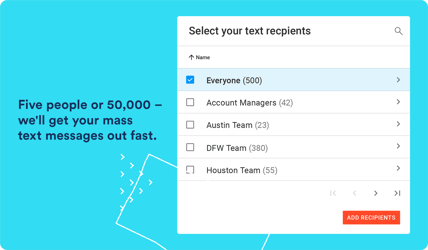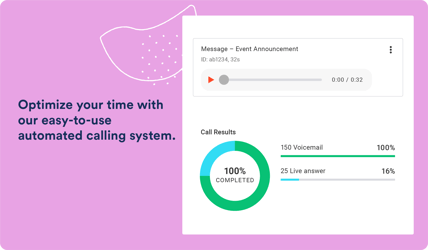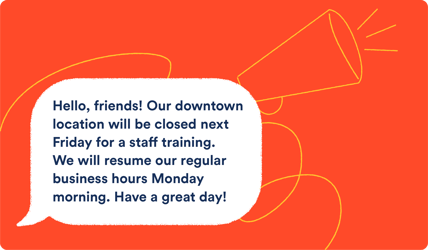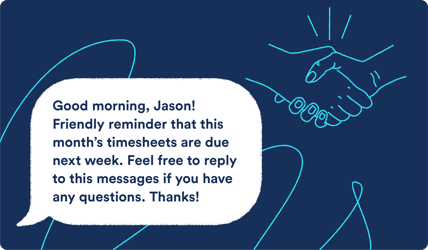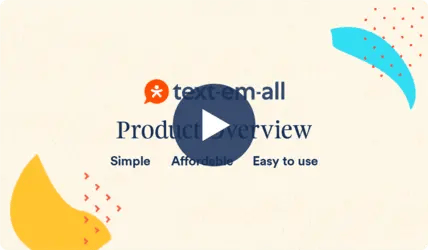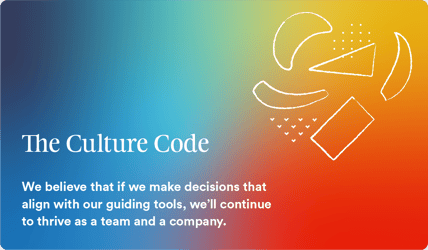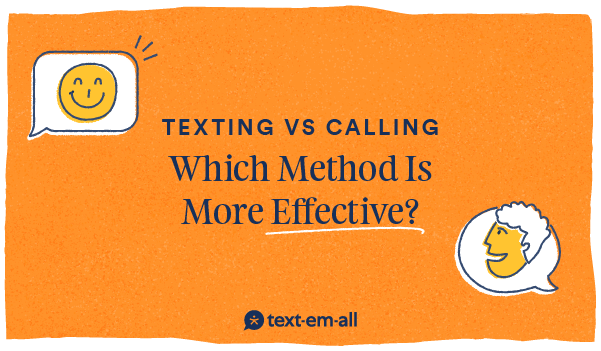
Communicating with your contacts might seem relatively simple. But how do you know if you’re using the right messaging method?
Whether you’re a staffing agency sending out job listings or a church sharing your community’s prayer requests, the choice between texting vs. calling can be critical to the success of your messages. The decision isn’t one-size-fits-all and often requires you to analyze your audience, business goals, and other factors.
In this blog post, we’ll explore the pros and cons of both calls and text messaging for mass messaging and provide insights into when it makes sense to use both.
Read The Complete Guide to Business Text Messaging
What to Consider When Making Your Choice
You should base your decision to call or text on a comprehensive analysis that considers the following factors.
Effectiveness in Communication
One of the primary advantages of making calls is the ability to convey emotions and nuances effectively through your tone. In addition, calls are also a great medium to use to share more detailed information. While your audience might overlook long texts, a call engages them while giving you time to share all your details.
On the other hand, text messages offer convenience, speed, and immediate eyes on your message. You can send a text in just a few taps, which makes it a quick and efficient way to share information. Additionally, text messages allow recipients to respond on their own time.
Audience Preferences and Behavior
Understanding your audience’s preferences and behavior is essential when choosing your mass messaging method. Different demographics and industries have varying tastes, so it’s important to align your method of communication with what your audience prefers.
- Consumer behavior and preferences. Studies show that if your audience is younger, they likely prefer text messages because they’re less invasive and more convenient. In contrast, older generations tend to prefer phone calls for a more personal touch. Consider your audience’s age, location, and cultural background when deciding.
- Demographics and industries. Preferences can also vary by industry. While healthcare providers might find it easier to share medical information over the phone, schools likely find it easier to send text message reminders to students, parents, and staff. Other industries, such as religious organizations, may use a mix of both methods to cater to their audience’s diverse needs.
Engagement and Response Rates
Measuring engagement and response rates can help you evaluate the effectiveness and decide which method is right for you.
- Voice messages typically result in more active engagement. Contacts will often respond to voicemails with a call, which can lead to immediate conversations and problem resolution. However, not everyone appreciates calls, and voicemails may go unnoticed for an extended time.
- Text messages = higher open rates and passive engagement. Text messages have higher read rates, as recipients can quickly glance at the message, even if they’re doing other things. This asynchronous communication can be effective for event reminders, surveys, and informational messages. However, this method may not offer the immediate problem resolution you experience on the phone.
Scalability and Cost-Effectiveness
When choosing your communication method, it’s important to consider the cost of each option to manage your expenses properly.
While sending mass voice messages is easily handled through a mass messaging platform, responding to your contacts' calls may be extremely time-consuming. This can translate into higher costs if you need additional help.
Text messages are highly cost-effective and easily scalable. Like phone calls, sending mass texts can be automated, allowing organizations to reach a large audience quickly. However, mass texting platforms can set up auto-replies, which can be a massive time saver.
Personalization and Customization
You cannot personalize mass voice messages, so they often aren’t the best option if you need to customize your message. However, text messages offer customization options that allow you to insert your contacts’ information (such as first name, last name, appointment time, etc.).
Texting vs. Calling At a Glance
|
Factors to Consider |
Calling |
Texting |
|
Effectiveness in Communication |
Conveys emotions and nuances effectively through tone. Can share more detailed information. |
Offers convenience, speed, and immediate visibility. Allows recipients to respond on their own time. |
|
Audience Preferences and Behavior |
Preferences vary by demographics and industries. Older generations prefer calls for a personal touch. |
Younger audiences prefer texts for being less invasive and more convenient. Preferences can vary by industry. |
|
Engagement and Response Rates |
Results in more active engagement. Voicemails may lead to immediate conversations. |
Higher open rates and passive engagement. Recipients can quickly glance at messages. May not offer immediate problem resolution. |
|
Scalability and Cost-Effectiveness |
Responding to calls can be time-consuming, leading to higher costs with a high volume of replies. |
Highly cost-effective and easily scalable. Mass texts can be automated, and auto-replies save time. |
|
Personalization and Customization |
Limited personalization in mass voice messages. Not suitable for customized messages. |
Offers customization options. Allows insertion of contacts’ information for a more personalized touch. |
When It Makes Sense to Choose Both
In many cases, businesses may find using both calls and text messages in their communication strategy helpful. Combining the strengths of both methods can lead to a more comprehensive and effective outreach. Here are scenarios where it makes sense to choose both.
When You Have a Diverse Audience
If your business caters to an audience with varying communication preferences, offering both calls and text messages ensures you cover all your bases.
When You Use Multi-Channel Messaging
Multi-channel messages that utilize both calls and text messages can be more effective in engaging your audience. For example, sending an informational text message with a follow-up call with more details can maximize the impact.
When You Include Time-Sensitive Information
When you need to convey time-sensitive information, a combination of a text message alert followed by a call can ensure that the message is promptly received and understood.
When You Offer Customer Support
Offering a range of communication options for customer support can improve the overall customer experience. Some customers prefer to solve their issues via phone, while others may opt for text-based support.
When You Provide Appointment Reminders
Healthcare providers and service-oriented businesses can use text messages to send appointment reminders and phone calls to answer patient questions or concerns.
Supercharge Your Mass Messaging Strategy with Text-Em-All
There is no one-size-fits-all answer in the ongoing debate of texting vs. calling for mass messaging. You should base your choice on your audience, business goals, and the specific context of your communication. Audience preferences, engagement rates, scalability, cost-effectiveness, and personalization are all critical factors to consider when making your decision.
Take some time to understand each method's unique strengths and limitations and align them with your objectives. You can then create a more effective and engaging mass messaging strategy that serves your business and your audience.
Through Text-Em-All’s platform, you can seamlessly switch between sending texts, voice messages, and broadcasts that combine voice and text. If you’re ready to harness the power of mass messaging to reach your audience, sign up for your free account today!


